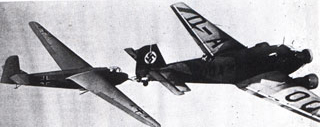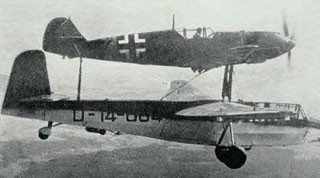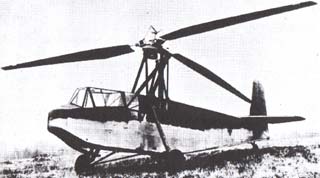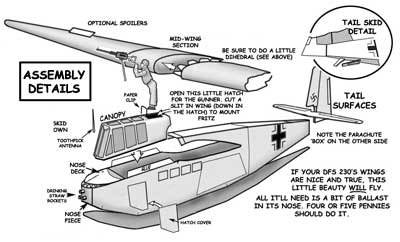

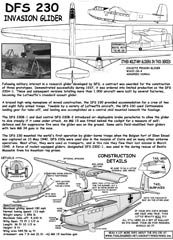
DFS Invasion Glider - $$5.50
Eight DFS 230 gliders, carrying 85 Pioneers under Leutnant Rudolf Witzig, landed on the roof of the Belgian fort of Eben Emael in the early hours of May 10, 1940. There had been no declaration of war, and they achieved surprise. Using the new shaped charges, they disabled the fort's guns and trapped the garrison inside. The assault cost only 21 casualties.
The WWII Nazi DFS-230 Invasion Glider
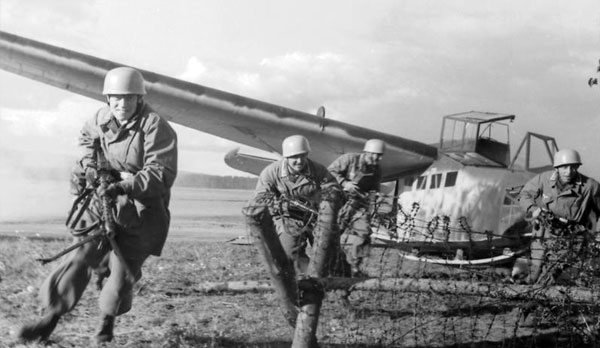
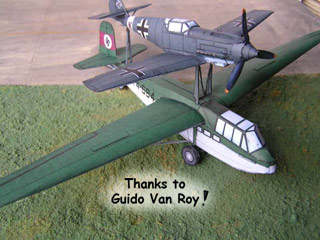
The first German combat glider, designated the DFS 230, had a wingspan of 72 feet and fuselage 38 feet long. The first use of this aircraft took place on May 10, 1940. In the half-light of dawn, shortly after 5 a.m., ten 230s carrying a total of 78 assault troops swooped down and landed on top of a huge Belgian fort, Eben Emael, a barrier to Hitler's invasion of Belgium and Holland.
Eben Emael garrisoned 800 men; was encircled by a moat; and had tank barricades, expanses of barded wire, machine gun nests, minefields and heavy artillery. However the roof of this heavily camouflaged fort was a meadow-like expanse 1,000 yards long and 800 yards wide. A perfect place for a DFS 230 to land.
DFS 230 Nazi Invasion Glider
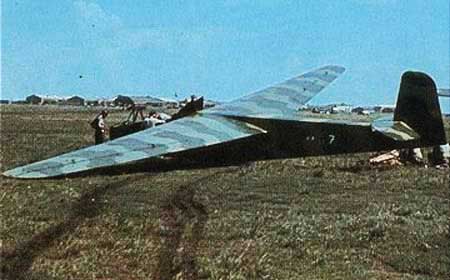
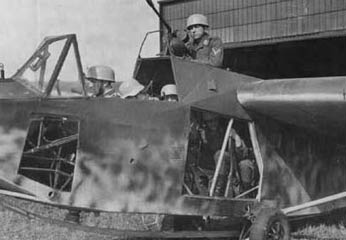 The concept of the combat glider can be traced to the outcome
of World War I. Under the provisions of the Treaty of Versailles,
Germany was forced to reduce its land army to a token 100,000
men and was prohibited from having an air force. Since the treaty
did not prohibit the building and flying of gliders, glider-flying
clubs sprang up throughout Germany. Within eight years after the
war ended, German high schools were offering glider flying as
part of their regular curricula. When the Nazis came to power
in 1933, the young men trained in gliders helped to form the core
of the new German air force, the Luftwaffe.
The concept of the combat glider can be traced to the outcome
of World War I. Under the provisions of the Treaty of Versailles,
Germany was forced to reduce its land army to a token 100,000
men and was prohibited from having an air force. Since the treaty
did not prohibit the building and flying of gliders, glider-flying
clubs sprang up throughout Germany. Within eight years after the
war ended, German high schools were offering glider flying as
part of their regular curricula. When the Nazis came to power
in 1933, the young men trained in gliders helped to form the core
of the new German air force, the Luftwaffe.
Hitler himself perfected the strategy of landing assault teams behind enemy lines, both day and night, in engineless aircraft. (Russia pioneered in this area with cargo gliders, though its gliders as troop carriers were never used in combat. However, after the war, Russia maintained three glider-infantry regiments until 1965.)
The first German combat glider, designated the DFS230, had a wingspan of 72 feet and fuselage 38 feet long. The first use of this aircraft took place on May 10, 1940. In the half-light of dawn, shortly after 5 a.m., ten 230s carrying a total of 78 assault troops swooped down and landed on top of a huge Belgian fort, Eben Emael, a barrier to Hitler's invasion of Belgium and Holland. Eben Emael garrisoned 800 men; was encircled by a moat; and had tank barricades, expanses of barded wire, machine gun nests, minefields and heavy artillery. However the roof of this heavily camouflaged fort was a meadow-like expanse 1,000 yards long and 800 yards wide. A perfect place for a glider to land.
|
|
The German gliders were towed by Junkers 52s, three-engine transports, from an airfield near Cologne. Their pilots circled to an altitude of 8,500 feet, and then flew a 45-mile course paralleling the German front lines. When the objective, 20 miles behind the Belgian border, was easily within reach, the glider pilots released. Twenty minutes after landing on top of Eben Emael, the Germans had sealed the garrison inside the fort at a cost to them of six dead and 20 wounded.
Besides the gliders, a key to the success of this daring mission was a top-secret, hollow-charge device which when detonated, imploded. That is, the charge blew inward, not up and out. These 100-pound explosives were placed against the steel-reinforced, concrete cupolas and turrets housing observation posts and large-caliber cannon. The tremendous blasts, each accompanied by a miniature mushroom cloud, instantly neutralized weapons and men, even those directly down in the bowels of the fort, with an inverted, volcanic shower of molten metal and concrete shrapnel.
The German armies arrived at Eben Emael the next morning, and by that afternoon the fort had been surrendered. Subsequently, Hitler used his combat gliders in Greece on April 26, 1941, and in Crete on May 20 of the same year. The Germans won the eight-day battle for Crete with the use of 13,000 glider infantry and paratroopers, but suffered over 5,000 casualties. Hitler never again used paradrops or gliders on such a massive scale.
|
|
The same forces are at work on a glider. Thrust is created by the tow plane. Drag is air resistance. Lift causes the glider to move forward against gravity. However, once the glider pilot cuts loose from the tow plane, the glider was nosed down, with gravity providing the necessary thrust. (In a sailplane, he same forces apply. Even if soaring higher and higher on a thermal or rising air current, the nose of the sailplane must always be pointed down at the proper angle to maintain airspeed - to maintain the proper flow of air over the wings for lift.)
At 04.30 hours on May 10, 1940, 82 aircraft began to take off from Ostheim and Butzweilerhof, on the outskirts of Cologne, to initiate what was to be one of the most audacious aerial operations of World War 11; an operation depending for its success on an entirely new weapon of war-the assault glider. Forty-one of the aircraft taking off from the two Cologne airfields were DFS 230A assault gliders, the first of their kind in the history of aerial warfare, the remainder being their Ju 52/3m tow planes.
Belonging to the Luftlandegesch wader 1, the Luftwaffe's first "'Airlanding" Geschwader and the first unit of its kind in the world, each DFS 230A carried paratroops whose tasks were the storming of the Eben-Emael fortifications and the capture of the Kanne, Veldwezelt and Vroenhoven bridges which were to be held until the arrival of ground forces.
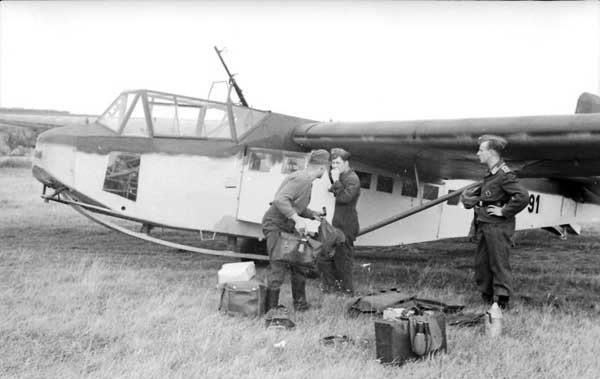
So successful was this operational initiation of the assault glider that virtually every aircraft manufacturing nation immediately followed Germany's lead and began the design and development of troop and freight -carrying gliders, while the Reichsluftfahrtministerium, which had previously expressed doubts concerning the operational value of Lastensegler (Cargo Gliders), promptly demanded that the highest priority be awarded the development and manufacture of larger aircraft in this category.
Designed by Hans Jacobs, the DFS 230, which was developed in the greatest secrecy and began flight tests late in 1937, stemmed from trials conducted in the mid 'thirties by the Deutschen Forschungsinstitut fur Segelflug (DFS) with a large glider intended primarily for high-altitude meteorological research and originally conceived by Rhon-Rossitten Gesellschaft. During a visit to Griesheim, Ernst Udet watched the flight testing of the glider which was towed into the air behind a Ju 52/3m, and was particularly impressed by its pinpoint landing capabilities.
Afterwards Udet remarked to his World War I comrade Oberstleutnant Robert Ritter von Greim that large gliders such as that he had seen at Griesheim. would, if suitably modified, provide a modern equivalent of the Trojan Horse, depositing troops silently and unnoticed behind an enemy's defenses. Within a few weeks of this conversation, the DFS had received instructions to design and build a glider capable of accommodating a pilot and nine fully-equip troops. The structural design of the DFS 230 was thoroughly conventional. The wing comprised a single main spar at approximately one-third chord with plywood covering forward and fabric the long-span ailerons with inset tabs were fabric covered, the wing was braced to the fuselage at quarter-span by light struts.
The fabric-covered welded steel-tube fuselage was rectangular section, and built up on a central keel member, boom intended to absorb the impact loads transmitted to the sprung steel skid. Provision was made for either single or duel control, and, in addition to the pilot, accommodation was provided for nine men who were seated on the central boom. As maximum permissible flying weight of 4,630 lb. Some 600 lb. of freight could be carried in addition to the full complement of 8 men.
A large loading door provided at the rear of the cabin in the fuselage portside, and loading of bulky items of freight was facilitated by a detach panel beneath the wing in the starboard side of the fuselage. For take-off a two-wheel dolly was provided, this being jettisoned once the glider was airborne, and early trials revealed gliding angle of 1:18 in fully loaded condition.
All initial trials were performed with the Ju 52/3m serving as a tug, but as tests progressed various other aircraft were employed in this role, including the He 46, the Hs 126, and the Ju 87B, and some tri were performed with a fully-laden DFS 230 towed by a team five He 72 Kadett training biplanes. From the outset of the DFS 230 development program Institute collaborated closely with the Gothaer Waggonfa which was to have initial responsibility for the quantity production of the glider, although this was slow to gather tempo in part due to lingering doubts within the RLM regarding the tactic, value of such aircraft, a vociferous faction declaiming that glider offered nothing not already offered by the appreciably expensive parachute.
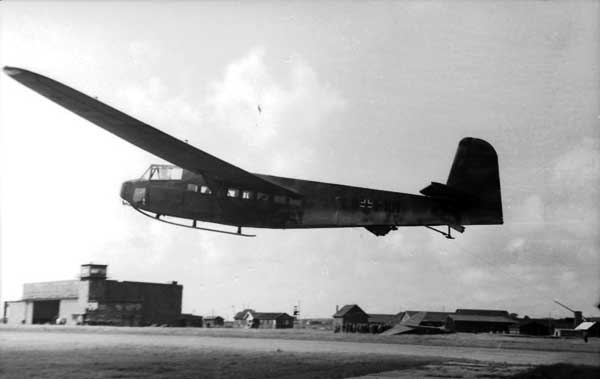
Three prototypes, the DFS 230 V1, V2 V3 assembled and tested by the Institute, were followed basm series of GWF-built pre-production DFS 230A-0 glides, deliveries of the production DFS 230A-1 and A-2, the latter dual controls, finally commenced in October 1939, a total 28 of the gliders having been accepted by the Luftwaffe by the end of the year.
During the autumn of 1938, a small glider-borne comma had been formed with the pre-production DFS 230s. Fliegerdi vision, developed assault techniques before combining with the existing paratroop cadres in the XI Fliegerko With the rapid increase in DFS 230 output from the beginning of 1940, the I Gruppe of Luftlandegesch wader 1, was formed, operational successes in May being followed by the establishment of II and III Gruppen, and the Gothaer Waggonfabrik being joined in the manufacture of the DFS 230 by several other concerns, including Hartwig at Sonneburg, Erla at Leipzig, and factory in Prague.
During the course of 1940 a total of 455 of the assault gliders was accepted by the Luftwaffe, the majority of e being the initial DFS 230A-1 sub-type. This version had succeeded on the assembly lines in the late autumn by the 230B-1 and dual-control B-2 embodying modifications ranging from experience gained during the first glider assault nations.
Specifications for the DFS 230 Nazi Invasion Glider
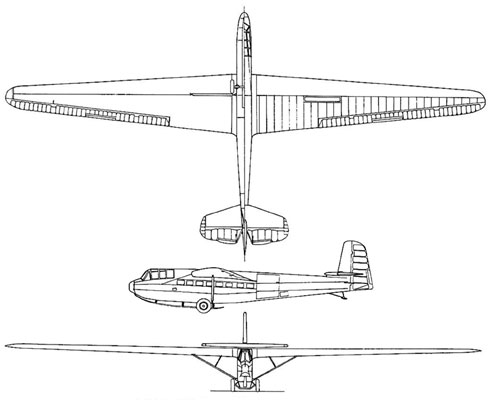 |
Crew: one, pilot |
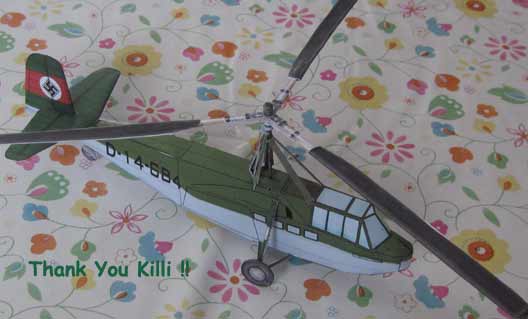 |



